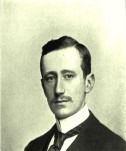Things To Make by Archibald Williams is part of the HackerNoon Books Series. You can jump to any chapter in this book here. A SELF-SUPPLYING MATCHBOX
XXXII. A SELF-SUPPLYING MATCHBOX.
This useful little article can be constructed in a couple of hours by a handy person. In general idea it consists of a diamond-shaped box to hold vestas, working up and down diagonally on a vertical member (A in Fig. 179 (1)), which passes through slits at the top and bottom, and runs in grooves cut in the sides of the box. The top of A is grooved to allow a match to rest on it. When the box is drawn up to the full extent allowed by a transverse pin in the slot shown in Fig. 179 (2), the groove is at the lowest point of the box, and is covered by the matches. When the box is lowered, A catches a vesta and takes it up through the top, as seen in Fig. 178, for removal by the fingers.
The only materials required are a cigar-box, some pins, and a supply of glue. The box should be carefully taken to pieces, and the parts soaked in hot water till freed of all paper, and then allowed to dry under pressure, small slips of wood being interposed across the grain to keep them separate and permit the passage of air.
[Illustration: FIG. 178.—Self-supplying matchbox, with match in position for removal by fingers.]
When the wood is dry, cut out with a fret saw two pieces shaped like Fig. 179 (3), to form the ends of the box. Allow a little surplus, so that the edges may be finished off neatly with chisel and plane. The two ends should match exactly, or there will be trouble at a later stage.
Now cut, down the centre of each a groove for one edge of A to run in. By preference it should be square; but if you do not possess the necessary chisel, a V groove made with a knife will suffice—and, of course, in this case the edges of A will have to be bevelled to fit.
[Illustration: FIG. 179.—Details of self suplying matchbox.]
The four sides of the box, BB and CC, are next cut out. Their sectional shape is shown in Fig. 179
(1). They should be rather longer than the length of the ordinary vesta, and all of exactly the same length, and rectangular. A very small hack saw (costing about 1s.) with fine teeth is the best possible tool for close cutting, and a small 1 shilling iron plane is invaluable for truing and bevelling the edges.
The glue pot, which we will assume to be ready for use, is now needed to attach the fixed B (the other B is hinged to form a lid for filling the box through) and CC to the ends. This operation must be carried out accurately, so that the slots may not be blocked.
While the glue is setting, cut out A, allowing an extra 1/16 inch of width for fitting. The slot down the centre is best made with a fret saw, and should be smoothed internally by drawing a strip of fine glass paper to and fro through it. The length of the slot is of great importance. It must reach to just that distance from the top edge which brings that edge flush with the bottom of the box when the box is raised; and in the other direction must permit the box to settle on to its foot, so that the match lifted shall project above the box.
Work the edges of A down carefully (double-bevelling them if the notches are V-shaped) till A will run easily, but not loosely, in the box. Then cut out two slips, DD, and bevel them at the top to an angle of 45 degrees. Put A in place and glue them on, taking care that the glue does not hold them fast to A.
Pierce a small hole through DD, in line with the slot, and insert a pin.
Draw the box fully up, and see if the top of A sinks to the proper place.
If it projects a little, lengthen the slot a trifle.
Cut out the supports EE, finish them neatly, and glue them to A. Make sure that the pin lets the box touch them.
Fix on the lid B with two pins for pivots, and fit a little catch made of brass wire. To give extra security, drive ordinary pins, cut off to 5/8 inch, through the sides into fixed B, CC, and DD, and through EE into A. This is an easy enough business if pilot holes are made with a very fine awl or a tiny drill, and a small, light hammer is used. It now remains only to go over the whole box with glass paper or emery cloth, and to glue a diamond of coarse glass paper to one end for striking the matches on.
Note that the lid must not be opened when the box is down, as it would be wrenched off its pivots.
About HackerNoon Book Series: We bring you the most important technical, scientific, and insightful public domain books.
This book is part of the public domain. Archibald Williams (2005). Things To Make. Urbana, Illinois: Project Gutenberg. Retrieved https://www.gutenberg.org/cache/epub/14664/pg14664-images.html
This eBook is for the use of anyone anywhere at no cost and with almost no restrictions whatsoever. You may copy it, give it away or re-use it under the terms of the Project Gutenberg License included with this eBook or online at www.gutenberg.org, located at https://www.gutenberg.org/policy/license.html.

